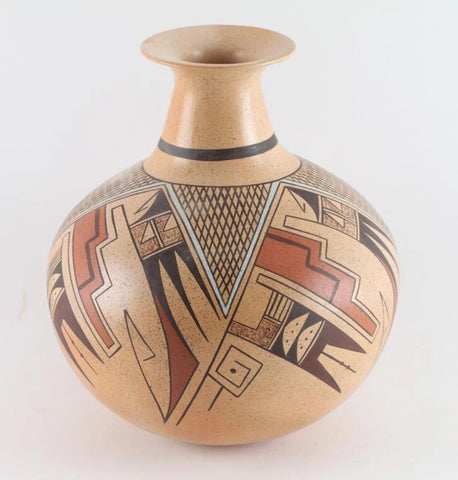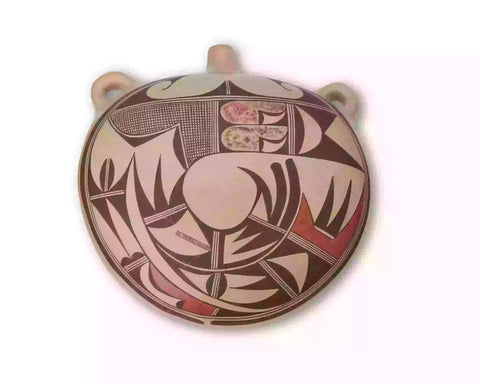
Hopi Pottery : 2 Very Good Hopi Pottery Jars By Adelle Nampeyo #292
$ 1,530.00
Hopi Pottery
292. Description: Ca. 1970's-1980's, Pair of small similar pottery jars, one with a yellow slip, the other buff. Both in very good condition. 2-5/8" x 3-3/8", 2" x 3".
Adelle Lalo-Nampeyo was born into the Corn Clan in the Hopi-Tewa Nation in August, 1959. She is one of the great granddaughters of the famous Nampeyo, who was known for reviving and expanding the beautiful ancient pottery designs from the archaeological site at Sikyatki on the eastern side of the Hopi First Mesa.
Adelle was inspired to learn the art of pottery making from her Mother, the late Elva Nampeyo. She was also taught by her Grandmother, the noted Hopi potter Fannie Polacca Nampeyo. She has been making pottery since 1979. She is the sister of Miriam Nampeyo, who also is a very talented Hopi-Tewa potter, as well as Neva Polacca, Choyou Nampeyo and Elton Tewaguna Nampeyo. She specializes in Traditional Hopi pottery, black and red on yellow jars and bowls.
Adelle specializes in the handmade traditional ancient Sikyatki polychrome pottery which her family is famous for. All of her materials are from Mother Earth. She hand coils all of her pottery the traditional way. She finishes her pottery by polishing it with polishing stones, paintig the designs with brushes made of yucca, and then firing the pottery in an outdoor firing pit, smothered with sheep dung.
Adelle says she enjoys making seed pots most of all because they are easier to work with. Her favorite design is the fine line and eagle tail. She strongly believes that she needs to continue making pottery the traditional way because of her strong spiritual beliefs. Adelle is now teaching her children the art that her ancestors have taught her so that they can continue in her footsteps.
Adelle signs her pottery as: Adelle L. Nampeyo, followed by a corn symbol to proudly denote her clan origin. (Source: Hopi Arts)
A History of Pueblo Pottery:
Pueblo pottery is made using a coiled technique that came into northern Arizona and New Mexico from the south, some 1500 years ago. In the four-corners region of the US, nineteen pueblos and villages have historically produced pottery. Although each of these pueblos use similar traditional methods of coiling, shaping, finishing and firing, the pottery from each is distinctive. Various clay's gathered from each pueblo's local sources produce pottery colors that range from buff to earthy yellows, oranges, and reds, as well as black. Fired pots are sometimes left plain and other times decorated most frequently with paint and occasionally with applique. Painted designs vary from pueblo to pueblo, yet share an ancient iconography based on abstract representations of clouds, rain, feathers, birds, plants, animals and other natural world features.
Tempering materials and paints, also from natural sources, contribute further to the distinctiveness of each pueblo's pottery. Some paints are derived from plants, others from minerals. Before firing, potters in some pueblos apply a light colored slip to their pottery, which creates a bright background for painted designs or simply a lighter color plain ware vessel. Designs are painted on before firing, traditionally with a brush fashioned from yucca fiber.
Different combinations of paint color, clay color, and slips are characteristic of different pueblos. Among them are black on cream, black on buff, black on red, dark brown and dark red on white (as found in Zuni pottery), matte red on red, and poly chrome a number of natural colors on one vessel (most typically associated with Hopi). Pueblo potters also produce un-decorated polished black ware, black on black ware, and carved red and carved black wares.
Making pueblo pottery is a time-consuming effort that includes gathering and preparing the clay, building and shaping the coiled pot, gathering plants to make the colored dyes, constructing yucca brushes, and, often, making a clay slip. While some Pueblo artists fire in kilns, most still fire in the traditional way in an outside fire pit, covering their vessels with large potsherds and dried sheep dung. Pottery is left to bake for many hours, producing a high-fired result.
Today, Pueblo potters continue to honor this centuries-old tradition of hand-coiled pottery production, yet value the need for contemporary artistic expression as well. They continue to improve their style, methods and designs, often combining traditional and contemporary techniques to create striking new works of art. (Source: Museum of Northern Arizona)
----------------
View the other items in my shop: http://www.etsy.com/shop/CulturalPatina?ref=shopsection_shophome_leftnav




